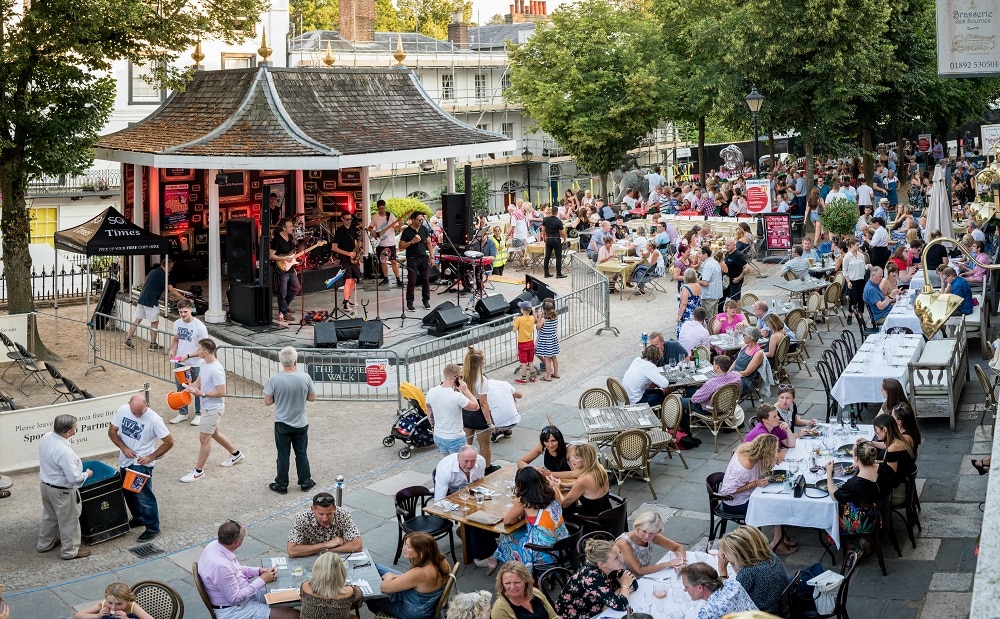TUNBRIDGE Wells remained the third most visited district in Kent for day trips, despite the pandemic, according to a report on tourist numbers to the area.
The borough saw about 2.3 million people visit in 2020, and combined, they spent around £77million during their trip.
But Covid-19 has cost businesses in the area more than £165million in lost revenue in the first year of the pandemic alone, according to the Kent Tourism Economic Impact Study 2020.
Published last week by Visit Kent— the body that promotes the county to visitors — the report has laid bare the true cost the pandemic on the shops, restaurants, hotels, attractions and car parks in the area.
It reveals, unsurprisingly, that visitor numbers to Tunbridge Wells fell by half during the first year of the pandemic compared to 2019.
This 48.6 per cent decrease in tourists saw day trips to the town and wider borough plummet from 4.4 million to just 2.3 million in 2020.
Overnight stays also fell from 312,000 in 2019 to just 144,600 due to the various lockdowns and government restrictions.
The cost to the local economy has been estimated to be around £165million, with income from tourism falling from £295million in 2019 to just £130million in 2020.
Using the Cambridge Economic Impact Model – the industry tool for measuring the effects of visitors to a given area – Visit Kent found that the decline in visitors in Tunbridge Wells also saw a 34 per cent fall in the number of jobs in the tourism sector, including in restaurants, hotels and pubs.
But Tunbridge Wells ranks as among the top tourist destinations in the county coming third for chosen locations for day trippers.
Canterbury, with its cathedral and medieval streets, had the second in Kent, with the city 3.8 million tourists in 2020, and those people spent around £101million during their stay. highest number of day trippers of the 12 districts
But topping the list was Dartford, largely due to its Bluewater Shopping Centre that helped the district attract 4.5 million people in 2020 who spent around £159million.
The report also found that around half of all visitors (47 per cent) that come to Tunbridge Wells do so for a holiday, with the average stay in the area being 3-4 days with people spending £220 during the trip.
People visiting friends and relatives accounted for 48 per cent of trips to the borough, while more than 22,000 people came from overseas.
Just 2 per cent of visits to the area were for business reasons.
Across Kent the pandemic has had a dramatic result on tourism.
Day trips to the county fell from 61 million to just 31 million in 2020 and overnight trips in Kent fell from 4.8 million to 2.1 million.
The value of tourism to the economy in the county plunged from £4.1billion in 2019 to £1.6billion in 2020 – a £2.5billion hit to the county’s businesses reliant on visitors.
Visit Kent chief executive, Deirdre Wells, called for ‘long-term support’ from the government following the release of the figures last week.
She said: “After a strong performance in 2019, our sector’s bold plans for 2020 were utterly disrupted by the Covid-19 crisis.
“This latest research is a stark demonstration of the direct impact on Kent’s brilliant tourism, leisure, and hospitality sector, which is one of our county’s biggest employers, and the life and soul of our high streets.
“The findings from 2020’s Economic Impact Study demonstrate exactly why our industry continues to need long-term support from central government, to enable a sustainable destination recovery.
She added that the county was ‘in a good position to recover from the pandemic, particularly given the strong level of support from local residents for our visitor economy businesses’.
She continued: “However, notwithstanding this support, it is likely that it will be many years – maybe until 2025 – before the industry recovers from its own version of long-Covid.”
However, the first signs that visitor numbers will rebound swiftly now that nearly all Covid measures have been relaxed, are beginning to show.
Already a number of venues in Tunbridge Wells are reporting customer levels are returning to pre-pandemic levels.
Emma Martin, Operations Manager at One Warwick Park Hotel and its restaurant STEAK, told the Times: “One Warwick Park Hotel has seen occupancy levels bounce back to very near pre-pandemic levels since August 2021 boosted by weddings and family gatherings.
“At STEAK, January diner covers were higher than those seen in the autumn last year, at a time when usually restaurant bookings are seasonally lower, suggesting a return to eating out confidence.”
Cllr David Scott, head of Economic Development at Tunbridge Wells Borough Council, said he is hopeful the tourism industry will bounce back.
He said: “The report’s findings won’t come as a surprise to anyone; it is difficult reading with the significant decline by
57 per cent of direct expenditure in the borough being a huge blow to local businesses.”
He continued: “The Council has sought to be as supportive as possible during this period, however these impacts put into perspective the £52million of support distributed to businesses to help them through the pandemic.
“We recognised the need for a strong exit from the pandemic and accordingly progressed with delivery of the Amelia Scott centre which will be an important new visitor attraction that will see up to 450,000 visitors per year attracted to the area.
“Hopefully as lockdown restrictions lift, we will see the tourism industry in our area bounce back better than before as the public show their support to local businesses.”








